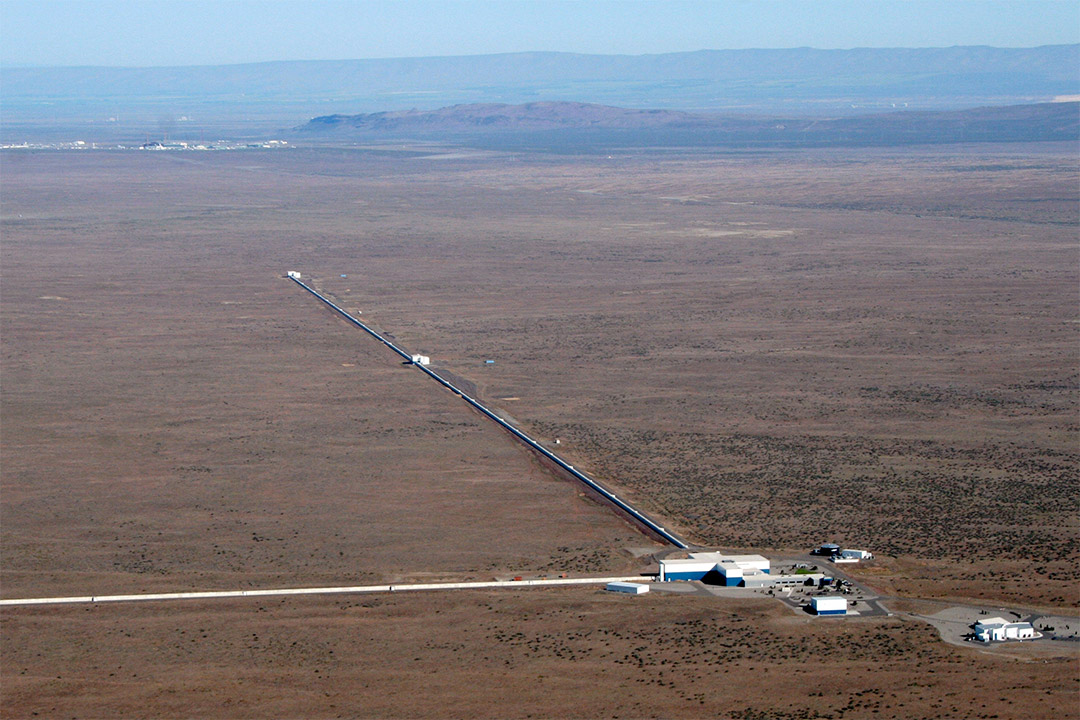Gravitational-wave detectors start next observing run to explore the secrets of the universe
RIT scientists excited by prospect of first detection of continuous gravitational waves
LIGO Scientific Collaboration
LIGO laboratory detection site near Hanford in eastern Washington.
The LIGO-Virgo-KAGRA (LVK) collaboration recently began a new observing run that promises to take gravitational-wave astronomy to the next level. According to scientists from across the globe—including those working on the project from Rochester Institute of Technology—this observing run, known as O4, features upgraded instruments, new and even more accurate signal models, and more advanced data analysis methods.
The LVK collaboration uses a network of observatories—LIGO in the United States, Virgo in Italy, and KAGRA in Japan—to search for gravitational waves, or ripples in space-time, generated by colliding black holes and other extreme cosmic events. RIT’s Center for Computational Relativity and Gravitation (CCRG) has an extensive group of students, faculty, postdoctoral researchers, and alumni involved in the LVK collaboration.
Beginning on May 24 and lasting 20 months, O4 will be the most sensitive search yet for gravitational waves. LIGO resumed operations May 24, while Virgo will join later in the year. KAGRA will join for one month, rejoining later in the run after some upgrades.
The first gravitational-wave signals were detected in 2015. Two years later, LIGO and Virgo detected a merger of two neutron stars, which caused an explosion called a kilonova, subsequently observed by dozens of telescopes around the world. So far, the global network has detected more than 80 black-hole mergers, two probable neutron-star mergers, and a few events that were most likely black holes merging with neutron stars.
As in previous observing runs, alerts about gravitational-wave detection candidates are being distributed publicly during O4.
“We’ve already seen some interesting events these last few weeks, including a possible black hole neutron star binary, as we prepared for our long observing run,” said Richard O’Shaughnessy, associate professor in RIT’s School of Mathematical Sciences. “With improved instruments and analyses, we’re excited to see what we catch in our net and find out how nature will surprise us over the next two years.”
With the detectors’ increased sensitivity, O4 will observe a larger fraction of the universe than previous observing runs. The LIGO detectors will begin O4 approximately 30 percent more sensitive than before. This increased sensitivity will result in a higher rate of observed gravitational-wave signals, resulting in a detection of a merger every two or three days.
In addition to the more frequent merger observations, the improved sensitivity helps the search for other sorts of signals.
“We’re hoping in O4 to make the first detection of continuous gravitational waves from a spinning neutron star,” said John Whelan, professor in RIT’s School of Mathematical Sciences, principal investigator of RIT’s group in the LIGO Scientific Collaboration, and co-chair of the LVK’s Continuous Waves Working Group. “These waves are fainter than inspiral and merger signals, but they’re ‘on all the time,’ so we can build up sensitivity to the signal over the whole run.”
“Several of our searches set interesting limits in O3, so with the improved O4 sensitivity, we hope to be moving into the discovery space,” continued Whelan. “Since a number of the neutron stars we’re going after are already seen in radio and X-rays, this is an exciting part of multi-messenger astronomy.”
“Thanks to the work of more than a thousand people around the world over the last few years, we’ll get our deepest glimpse of the gravitational-wave universe yet,” said Jess McIver, the deputy spokesperson for the LIGO Scientific Collaboration (LSC). “A greater reach means we will learn more about black holes and neutron stars and increases the chances that we find something new. We’re very excited to see what’s out there.”
Gravitational-wave observatories
LIGO is funded by the NSF, and operated by Caltech and MIT, which conceived and built the project. Financial support for the Advanced LIGO project was led by NSF with Germany (Max Planck Society), the U.K. (Science and Technology Facilities Council) and Australia (Australian Research Council) making significant commitments and contributions to the project. More than 1,500 scientists from around the world participate in the effort through the LIGO Scientific Collaboration, which includes the GEO Collaboration.
The Virgo Collaboration is currently composed of approximately 850 members from 143 institutions in 15 (mainly European) countries. The European Gravitational Observatory (EGO) hosts the Virgo detector near Pisa in Italy, and is funded by Centre National de la Recherche Scientifique (CNRS) in France, the Istituto Nazionale di Fisica Nucleare (INFN) in Italy, and the National Institute for Subatomic Physics (Nikhef) in the Netherlands.
KAGRA is the laser interferometer with 3 km arm-length in Kamioka, Gifu, Japan. The host institute is Institute for Cosmic Ray Research (ICRR), the University of Tokyo, and the project is co-hosted by National Astronomical Observatory of Japan (NAOJ) and High Energy Accelerator Research Organization (KEK). KAGRA collaboration is composed of over 480 members from 115 institutes in 17 countries/regions.










